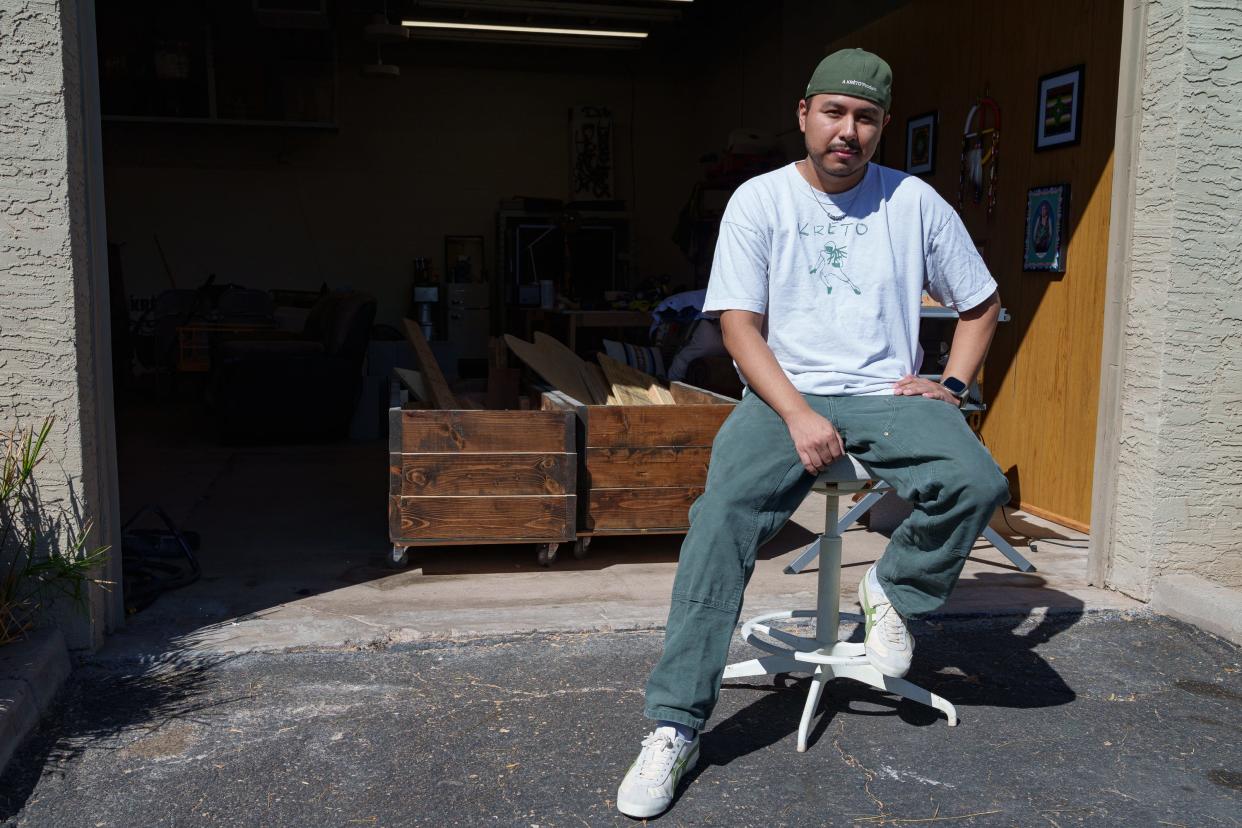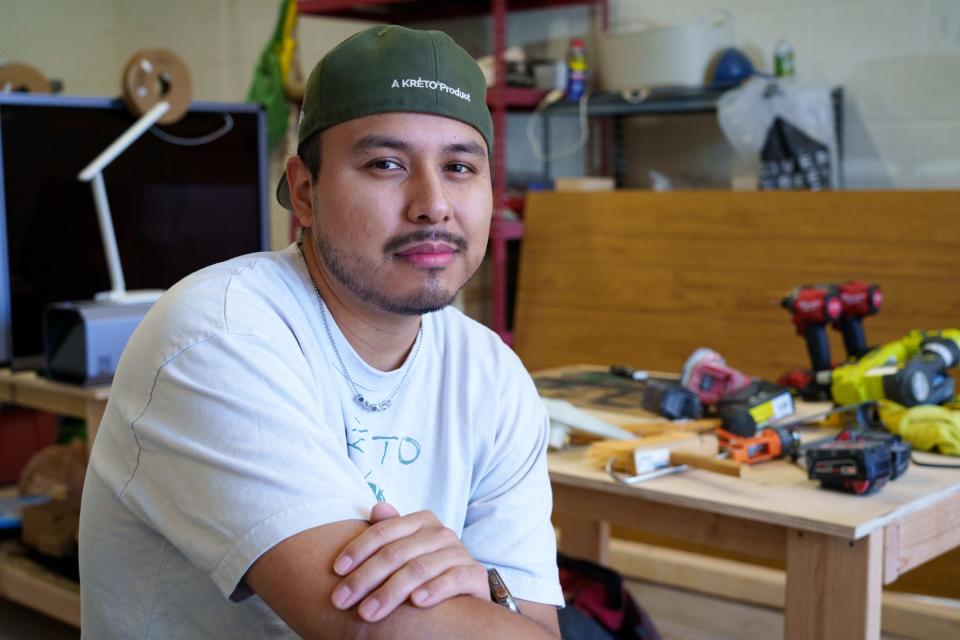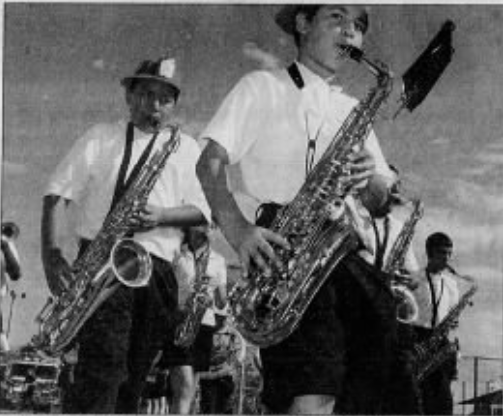'Representing where I am from': For Ray Ramirez, concrete is at the heart of Krèto

There's a familiar tone in Ray Ramirez's manner of speaking. If you were raised in the west side of Phoenix, it's hard to miss.
The 29-year-old creative and entrepreneur from Maryvale, is easy to spot, often rocking a green tote with "KRÈTO" in big white letters.
Krèto is a decor and lifestyle brand that he founded in 2020. What started off as simple artisan concrete planters evolved into a medium for Ramirez to express his creativity, develop a sense of belonging and connect with those he sees reflected in his work.
Driving around the city he started to notice something.
“The people that build the city, who fix the roads and everything — they all look like me," he said in an interview with The Arizona Republic.
He is referring to the nearly 43% of the 1.6 million people in Phoenix who identify as Latine, most of whom are Mexican or of Mexican descent — people who have had a major influence on the identity of the city itself.
The celebration of Mexican heritage can be seen blown up on the side of buildings in murals with imagery that represents the same Brown faces leading grassroots political movements, working the kitchens of Phoenix's culinary favorites and creating spaces for local artists.
His connection to Phoenix and its people is what inspired Ramirez to take a chance on his dreams of creating something for himself and contributing something to a city he's called home since he was a child.
Concrete, a material connected to his people
At the genesis of Krèto is a man who loves to work with his hands.
In his early twenties, Ramirez took a summer gig working with a friend in landscaping and construction in Phoenix.
This would expose him, for the first time, to working with concrete. He became infatuated with the material.
“I love the idea of imperfect shit,” Ramirez said. “If you look at concrete, it’s full of holes, there’s cracks in it. I love it.”
There was a symbolism to it too, Ramirez found, allowing him to associate concrete with the laborers, the people that he worked with who shared his Mexican identity.

His curiosity led him to look into some of the material's early uses. In his research, he found that older cultures used early versions of concrete, including in the construction of Mesoamerica.
“It made me proud to be working with a material that my people are working with," he said.
Concrete can be found in almost every building, intersection, parking lot and public work in metro Phoenix.
“Anybody can buy concrete, you go to Home Depot and buy a bag that is already ready, you just add some water," Ramirez said.
After his stint working in construction, Ramirez paused his work with concrete. As a child of an immigrant, he was steered in the direction of education as a pathway to better economic opportunities.
A career in engineering is what he thought would be his ticket out of poverty. Years later, he would find himself working an office job he did not feel passionate about.
“I felt like I was on an island,” Ramirez said. “I was clocking in to work doing something I hated and in our culture we don’t really know what depression is," referring to how taboo talking about mental health is in Latine households.
He sought out a doctor and was diagnosed with clinical depression. Still, he felt the pressure to stay at his job in order to be able to support his mother, just as she had done for him.
Ramirez's mom, Livier Cajero, 60, originally from Jalisco, Mexico, migrated to Los Angeles in the 1970s at the age of 11.
She became a mother at 30 and raised Ramirez in Los Angeles for the first four or five years of his life. But after being laid off from her job as an educator, she had to figure out how to provide for him. That was when moving to Phoenix became an option for her and her young family.
“I remember I only had $200,” she said. “It was a Sunday in 1998. It was Dec. 13. I had planned to leave on Dec. 12 in honor of el Día de la Virgen de Guadalupe, but there were no tickets left for the bus.”
With her luggage in one hand and Ramirez and his little backpack in the other, they waited for their bus at the Greyhound station in Los Angeles with two tickets to Arizona.
It was this same journey, however, that inspired Ramirez to embark on his own.
Intentionally sculpting art for and of Phoenix
Just as Ramirez was diagnosed with depression, the COVID-19 pandemic hit.
Ramirez decided to take some time off work. He remembered telling himself that he would take the time to figure out a different gig.
Krèto would begin to take shape, building a foundation for his future business plans.
“From there I started to focus more on artistry,” he said.
Ramirez knew the value of having brand recognition and studied the success of streetwear brands who often collaborated with established artists.
“Nobody knows who I am at that point right, it’s just homies,” he said, remembering what it was like pushing into that creative space. He began to tap into his network of creative friends, forming partnerships.
Some of his first customers were the very same people who inspired him to take up making concrete planters.
Collaborations with artists like Isaiah Vigil and Joshua Castañeda stayed true to the vision of sculpting something for and about Phoenix. Ramirez grew an audience of people who not only were seeking pots for their plants but who wanted something that represented their community.
Brandon Lopez is another artist whom Ramirez has worked with on projects for Krèto. Lopez is a community photographer in Phoenix whose work includes highlighting the experiences of undocumented people in the Valley.
He and Ramirez first connected in October 2020 during a gallery show of Lopez’s work, titled “A Better Life," hosted at the downtown barber shop and art space The Greater Good.
Lopez recalled a warm introduction to Ramirez which stood out to him from how people tend to approach strangers in creative spaces.
“He’s one of those people that if he knows you or about you, he won’t pretend otherwise,” Lopez explained. “He’ll come up to you and be like ‘Hey, you’re this person right?’”
Shared experiences in their upbringing, such as being raised by single mothers, shaped an understanding between the two. They created a friendship before working together finding inspiration in each other’s passions.
Ramirez asked Lopez to help document Krèto as it grew. They would go on to work on various campaigns for the brand, including a collection titled “Grown from the Concrete” by Krèto and Inland, a local streetwear brand.
The series of photos and videos for that project were filled with faces that make up Ramirez’s community. Lopez credits the success of that project to the space that Ramirez cultivates.
“The way he maneuvers is with so much intention and so much belief that it doesn't matter when something comes out, because he's done everything that he can to do it the right way,” Lopez said.
Ramirez runs his brand out of his artist studio in Tempe. This has allowed him to bring other creatives in and experiment with the direction of Krèto.
'Representing where I am from'
Ramirez views Krèto not just as a reflection of his and his team's efforts, but also how people outside of the city understand what Phoenix has to offer.
"I'm so excited about representing where I am from," he said.
Ramirez was born in Los Angeles, but after having lived in the Phoenix for more than 25 years, he considers this city his home. And he has his mom to thank for that.

Cajero raised Ramirez on her own and watched her son grow unafraid of delving into his creative interests.
"To tell you the truth, I thought he was going to be a rapper," she said laughing, remembering how her son was able to keep up with his favorite artists, rapping alongside them to her amazement.
Ramirez surrounded himself with music, playing the saxophone for his middle school, in the Marc T. Atkinson Middle School Band, located near 51st Avenue and Indian School Road.
The Republic wrote a feature on the band in 2005, where a young Ramirez can be seen with his saxophone.
Cajero keeps a copy of the newspaper as a point of pride.
This article originally appeared on Arizona Republic: Meet Ray Ramirez, the creative mind behind Krèto in Phoenix

